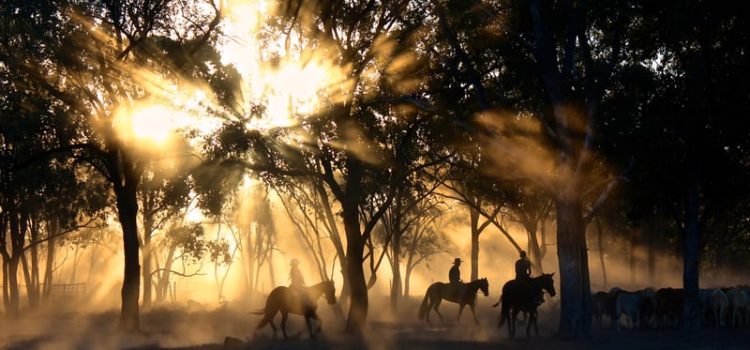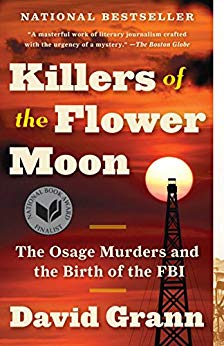

This article is an excerpt from the Shortform summary of "Killers of the Flower Moon" by David Grann. Shortform has the world's best summaries of books you should be reading.
Like this article? Sign up for a free trial here .
What was the legacy of law enforcement in the old west? How did law enforcement change over time?
In many places of the old west, law enforcement remained unorganized and was left to people who were criminals themselves. When the Osage murders occurred in 1920s Oklahoma, the system was ill-prepared to handle the investigation.
Continue reading to learn about law enforcement in the old west and how the Osage murders brought about major reforms.
Law Enforcement in the Old West: Frontier Justice
Elements of the frontier justice system, or law enforcement in the old west, remained in these parts of rural Oklahoma in the 1920s. Police forces were not yet fully professionalized, so ordinary citizens still assumed some of the responsibilities of criminal justice, including the investigation of evidence and even the pursuit of suspects.
This was a relic of old American attitudes toward official police departments in the history of American law enforcement, dating back to the era of the Revolutionary War. Americans of that time feared that professional law enforcement agencies, like standing armies, would become instruments of oppression that would trample upon their rights and liberties. It was only with the spread of industrialization and urbanization, and public fear of the crime that was expected to follow in their wake, that professionally staffed police departments emerged.
One of the remaining vestiges of the former rough-and-tumble approach to criminal justice was the citizens inquest, to which the murder investigation of Anna Brown was subjected. According to the history of American law enforcement, in a citizens inquest, members of the community visited the scene of a homicide with the county coroner to collect evidence and record any witness testimony. The all-white members of Anna’s inquest were selected not for any particular expertise, but merely for being the first white men to arrive on the scene. The amateurish and careless examination that followed adhered to no forensic protocol. There was no canvassing of the area for footprints or shell casings and no dusting for fingerprints. To make matters worse, the presence of the large crowd contaminated and compromised the crime scene, significantly hampering the subsequent investigation.
Anna’s body was already badly decomposed when it was discovered, with the corpse emitting a nearly unbearable stench in the May heat. The primitive autopsy was an awful and grisly affair—onlookers gawked as the coroner dismembered Anna’s putrefying remains, using the most primitive of instruments and taking little care to respect her body or the mortuary practices of the Osage. Her mother and sister Mollie were present while the coroner performed his grim task on the barely recognizable body, identified only by her clothes and the gold fillings in her mouth. During the course of the gruesome procedure, Anna’s body was cut open and her cranium was sliced open to extract her brain. After seeing a small bullet entrance wound at the back of the head, the coroner pronounced Anna’s death a homicide.
He was not alone in conducting the examination of Anna’s remains. He was joined by two local doctors, James Shoun and David Shoun. Although they had identified the entrance wound at the back of Anna’s head and pronounced her death a murder, they could not locate the bullet. Also on the scene was the sheriff of Osage County, a man named Harve Freas.
Freas represented the traditional, informal approach to law enforcement that was still the practice’s guiding philosophy in this remote region of the United States at this time and was typical of law enforcement in the old west. He, like many rural sheriffs, was not a professionally trained law enforcement official. He was a rugged frontiersman, a relic of the Old West, in which so-called “lawmen” were little more than criminals themselves. These lawmen tended to have little regard for the law itself, frequently administering violence while turning a blind eye to gambling and bootlegging activities. Freas was cut from this cloth, having connections to known outlaw figures in the area.
The Changing Face of Law Enforcement
In the summer of 1925, Tom White was the special agent in charge of the Bureau’s Houston office, a man with a history of law enforcement in the old west. White straddled two worlds—on the one hand, he was an old-style lawman with no formal police training, a former Texas Ranger who had spent most of his career pursuing bandits on horseback throughout the Texas frontier, armed with a six-shooter. With his Stetson hat, he even looked like a caricature of the mythical Western lawman, still known to carry his trusty six-shooter when he was on dangerous assignments with the Bureau.
But on the other hand, despite his rough-and-tumble background, Tom had a reputation as a restrained, methodical investigator. Even during his days with the Rangers, a force well-known for its shoot-first methods, Tom had been different. He had discovered that careful observation and a methodical approach were more effective in catching criminals than running around the countryside, guns blazing. Tom recognized that many of his fellow Rangers were little more than violent criminals with badges and saw that it was a very fine distinction between a good man and a bad one. He knew that it was dangerous for one man to have the unrestrained ability to take a life, even if he was acting with the sanction of the law. Unlike his peers, he was against many methods of law enforcement in the old west, and ideas traditionally used in law enforcement history.
Tom’s father, Emmett, had been a sheriff in the wild land of Central Texas in the late 19th century. In those days, local sheriffs often were responsible for running the county jail and performing the executions of convicted criminals—Tom first saw his father hang a man from the gallows in 1894, when he was just an adolescent. The family lived next door to the jail, which held all manner of violent criminals, including murderers, rapists, arsonists, and robbers. Despite this harsh environment, Emmett did what he could to ensure relatively humane treatment of the prisoners in his custody and took a harsh stance toward anyone in the county who attempted to mete out vigilante justice—which, in Texas, often meant lynchings of black people.
Tom’s career in law enforcement was relatively bloodless, and he prided himself on the fact that he had never killed anyone in the line of duty, a rarity for an officer of his time and place, and a rare peacemaker in law enforcement in the old west. His approach to law enforcement was more modern and less bloodthirsty than his background would have suggested, and it earned him a strong reputation within the Bureau of Investigation.
J. Edgar Hoover and the Future of the FBI
In law enforcement history, the FBI was not always the giant it is today. In its early years, the Bureau was beset by a reputation for corruption and was embroiled in the scandals that had rocked the administration of President Warren G. Harding. With its propensity for accepting bribes and enabling all manner of corruption, it became known in the press of the early 1920s as “The Department of Easy Virtue.” In 1924, President Calvin Coolidge’s Attorney General, Harlan Fiske Stone, appointed the 29-year-old J. Edgar Hoover to head up the Bureau. His post was meant to be temporary, with a mandate to clean up the agency and restore its tarnished public reputation—but Hoover was to remain in his position until his death in 1972, nearly half a century later.
Over the years of law enforcement history, Hoover would amass enormous bureaucratic power, with his reign spanning eight presidencies. The Bureau of Investigation, which, in 1935, was renamed the Federal Bureau of Investigation (FBI), would come to have incredible power and political immunity.
Hoover was a relentlessly ambitious figure, and he saw in the Osage case an opportunity to flex his agency’s muscles and impose his modern vision of law enforcement. He would use the Osage murders to build up the organization that would, in 1935, become the all-powerful FBI and change the image of American law enforcement, from one of rugged frontier lawmen to sober, rational, scientific, and professional investigative agents.
In the 1920s, the history of American law enforcement changed forever. With more organized systems, and the end of models of law enforcement in the old west, the FBI and other police organizations began moving toward the structures they are today.

———End of Preview———
Like what you just read? Read the rest of the world's best summary of David Grann's "Killers of the Flower Moon" at Shortform .
Here's what you'll find in our full Killers of the Flower Moon summary :
- How the Osage tribe had vast oil wealth, but had it seized by their murderous neighbors
- The brutal and unresolved murders of Osage Native Americans
- The complicated history of the FBI in profiting from the Osage murders






